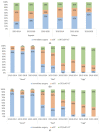Determinants of Pre-Surgical Treatment in Primary Rectal Cancer: A Population-Based Study
- PMID: 36831497
- PMCID: PMC9954598
- DOI: 10.3390/cancers15041154
Determinants of Pre-Surgical Treatment in Primary Rectal Cancer: A Population-Based Study
Abstract
When preoperative radiotherapy (RT) is best used in rectal cancer is subject to discussions and guidelines differ. To understand the selection mechanisms, we analysed treatment decisions in all patients diagnosed between 2010-2020 in two Swedish regions (Uppsala with a RT department and Dalarna without). Information on staging and treatment (direct surgery, short-course RT, or combinations of RT/chemotherapy) in the Swedish Colorectal Cancer Registry were used. Staging magnetic resonance imaging (MRI) permitted a division into risk groups, according to national guidelines. Logistic regression explored associations between baseline characteristics and treatment, while Cohen's kappa tested congruence between clinical and pathologic stages. A total of 1150 patients without synchronous metastases were analysed. Patients from Dalarna were older, had less advanced tumours and were pre-treated less often (52% vs. 63%, p < 0.001). All MRI characteristics (T-/N-stage, MRF, EMVI) and tumour levels were important for treatment choice. Age affected if chemotherapy was added. The correlation between clinical and pathological T-stage was fair/moderate and poor for N-stage. The MRI-based risk grouping influenced treatment choice the most. Since the risk grouping was modified to diminish the pre-treated proportion, fewer patients were irradiated with time. MRI staging is far from optimal. A stronger wish to decrease irradiation may explain why fewer patients from Dalarna were irradiated, but inequality in health care cannot be ruled out.
Keywords: chemoradiotherapy; magnetic resonance imaging; neoadjuvant therapy; population-based; preoperative therapy; radiotherapy; rectal cancer; treatment guidelines.
Conflict of interest statement
The authors declare no conflict of interest.
Figures



References
-
- Braendengen M., Tveit K.M., Berglund Å., Birkemeyer E., Frykholm G., Påhlman L., Wiig J.N., Byström P., Bujko K., Glimelius B. A randomized phase III study (LARCS) comparing preoperative radiotherapy alone versus chemoradiotherapy in non-resectable rectal cancer. J. Clin. Oncol. 2008;26:3687–3694. doi: 10.1200/JCO.2007.15.3858. - DOI - PubMed
Grants and funding
LinkOut - more resources
Full Text Sources
Miscellaneous

